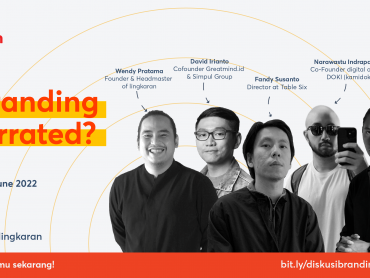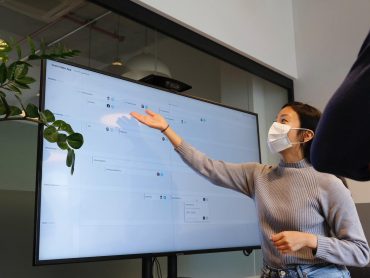
2017 Review – How to Thrive Your Creative Business in Today’s World
–
What a year it’s been!
We are already on the first week of 2018. I guess it’s not too late for us to reflecting on the things we achieved, lost, messed up, and rose above. Every year seems to feel like the most exciting, stressful, eventful year in memory, but I think in the case of 2017 it might actually be true. If I had to choose 1 word to describe 2017, I would use fundamental. A lot took place that I believe will have lasting impacts on me both professionally and within our team personally.
2017 was our 3rd year since we established in 2014, it was also remarked as a new journey for lingkaran’s team season 4. We grew triple into 12 passionate people. Even though some of them have ‘graduated’ before the year ended, but we were lucky enough to have all them in our team. There were also some milestones and important events that we won’t mention one by one – but that isn’t my intention to write this article.
I want to seize this moment to share our stories since the beginning of lingkaran establishment, how an idealistic idea – which initially I didn’t know how to make a living from it, can develop into a profitable and impactful business – thus far we managed to get 1500x profit from the initial capital and help 4,000+ people to grow. Although from our point of view we are still far from our target and that makes us always striving to pursue it.
–
—
From my perspective, the current education system does not meet the needs of young people who can create change. Ecological, social, and economic transformations are taking place. Of my findings, there is a big missing gap between what are given in formal schools and what are really needed in professional world. Demand for job vacancy is high, but at the same time finding a job is also difficult for young professionals. Meanwhile, the number of students who think they pick the wrong major is also increasing every year. On the other hands, the young generation, Millennials, clearly value entrepreneurship and want to start their own business, especially in Creative Industry.
It leaves not just a problem, but also a big opportunity. We’re striving to reinvent and redefine the education, helping young people to follow their passion and make things happen. Things that will bring smiles to their own faces and to the faces of the people they work with, while adding in beautiful and meaningful ways to the environment in which we live. We agree with creativity and education expert Sir Ken Robinson when he says that most schools kill creativity. And they kill independent thinking and the entrepreneurial spirit too. Demanding the “right” answers to tests does not encourage people to be adventurous in finding new ways to do things, or to question existing systems.
—
–
I try to summarize what we’ve done, what we’ve been through in the past 3 years and what we should be doing in the following years. I will divide our story into 2 parts. The first one is about “How to build your creative business?” and second one is “What happened in the world today?”. At the end of the article we hope you can conclude yourself how you can build and thrive your creative business in today’s world, especially in 2018, a year when technology will be growing rapidly and digitalizaton will be increasingly widespread.
–
–
Thriving Creative Business
–
01 – Discover Your Purpose
“The two greatest days of your life are the day you were born, and the day you find out what your purpose is.” – but if you don’t know what your purpose is than you don’t know why you are here, and it can be hard to keep going. I know this feeling all too well. I struggled daily to figure out my purpose, but it wasn’t until I took a step back and realized that my purpose isn’t always my passion. Maybe the world passion sounds more friendly in our ears. But trust me, passion changes and purpose stays. Purpose means the real reason why we’re here at all — the very reason we exist.
I do believe what Simon Sinek said, “Always start with why”. If you ask me “Is my passion in education?”, I would answer no. But my purpose and believe maybe is. What keeps me going on? I tell you one story, a story when my cofounders and former team left me. Back then I was on my weakest point and my biggest vacillation; Should I continue lingkaran by myself? Should I quit it and find another job? or create another startup? or get my master degree? Am I doing a right thing? Is it a thing that I want? I was questioning my own question and had a train of though coming on. And suddenly, one day, one of lingkaran’s mentor texted me and said that one of his participants in lingkaran’s class were able to develop his brand and business because of lingkaran. That was the moment that made me realize all of the things that I’ve been doing, that I was doing a right thing, that what I believed in lingkaran really did have an impact to our community. That was the moment when I found my purpose.
–
02 – Empathy is at the Heart of Our Business
I believe business is one of a vehicle for us to solve problems that we found and want to addressed. It makes us to not only have to know but also understand what the real problems are, what our targeted customers need from us. In lingkaran, we always started from the people, our targeted customers, our community. And after that we build deep understanding of the problems and realities of the people we are designing for. Without the understanding of what others see, feel, and experience, our solution or our business is a pointless task.
Design empathy is an approach that draws upon people’s real-world experiences to address modern challenges. When companies allow a deep emotional understanding of people’s needs to inspire them—and transform their work, their teams, and even their organization at large—they unlock the creative capacity for innovation.
–
03 – People Come and Go, but System Stays
It doesn’t mean that I don’t believe in people. lingkaran’s team is one of our biggest asset. I always give my best to find and maintain The A team and hope that they will stay longer with lingkaran. But another important thing that I should do is to establish the foundation of strong system as long as they are still with me. Develop a solid workflow and standard operating procedure while maintain your best team. Because people come and go, but system stays. So make sure your system is ready to welcome your next best team.
–
04 – Hold the Vision, Trust the Process
Like many entrepreneurs, I’m constantly thinking about the direction I want to go—refining my marketing message, products, services, community, to be the best they possibly can be. I dream about it. I doodle notes about it. It’s always in the back of my mind. I have it all sketched out, and I “just need to find the time” to put it together. I understand “Hold the vision” to allude to a sense of focus and concentration. This focus and concentration must be channelled towards a vision. And what about “trusting the process”? Trusting the process is about acceptance and embracing circumstances, with the belief that they are leading you to your vision. Pause and ponder that!
I am surrounded by people from technology background and businesses. They always said that speed is one of the decisive factor. And it always left me wondering, how can I combine the speed, efficiency and effectiveness, with fundamental and high quality result. I am working in education industry, an industry which is to be globally-known as complicated business. And I chose to try to fix the long time-problem; or at least give an alternative besides that. So what can I do is to hold my vision, and trust the process. Do it with my own phase. Open-minded and be agile. Learn, try, fail, and learn again. I just have to believe it.
–
05 – Explore Where (else) the Money Come from
Who said your main targeted customers should be your main revenue generator? Today’s business allow us to explore the source of income. Business model innovation is one way to explore it. Business model innovation is the development of new, unique concepts supporting an organization’s financial viability, including its mission, and the processes for bringing those concepts to fruition. The primary goal of business model innovation is to realize new revenue sources by improving product value and how products are delivered to customers. The digital age has become an impetus for business model innovation, as technology has dramatically changed how companies operate and deliver services to customers. This digital disruption has shortened business model lifecycles and made innovation key to financial success.
After the first year struggling with our B2C business model, we’ve finally found out our B2B business model. Since then we were not help our community to develop, but also big companies to develop their internal employees and multi-national brands to engage with young entrepreneurial market. Both we did through creating and developing programs and contents. We are always trying our best to balance between our B2C and B2B businesses. And we won’t found our B2B model without experience and reputation in B2C first, absolutely we couldn’t do it without you, Creatives!
–
06 – Believe in the Power of Community
We always believe in the power of community since the very beginning. We built our community around our brand. We always treat our customers like our friends. We are engaged with them, talk to them, and listen to them. We stayed true with our brand, and stayed true to our community – we grew together with them. Without all of our community, from learners, mentors, partners, to clients, lingkaran maybe won’t be existed until today.
Building a community is absolutely a great way for small businesses to engage more fully with our target audiences. This concept is related to brand building, but there are some important distinctions. When we build a community, the people involved (including customers) feel like they are part of what we’re doing. The word “community” can refer to many things, from a small town, to an online forum, to a loosely knit group of people who share certain experiences. If we want to build a community around a business, we will have to focus on the latter definition — one that emphasizes a shared interest or type of experience. This goes beyond selling products or even building brand loyalty.
–
07 – Make Money while Making Impacts
Making money while making the world a better place – what could possibly be better than that? That is exactly our goal. We want to do good while doing well. Every years we measured ourself with two big success KPIs; Financial KPsI and Impact KPIs. Until now, we managed to assist 400+ organizations, help 4,000+ people to grow, inspire 65,000 people, and created infinite collaborative opportunities.
We never label ourself as social enterprise or socio-preneur or anything like that. But like I mentioned before, we do believe that business is our vehicle to solve problems that we want to address. And we chose business as our vehicle is because we want to make it more sustainable. So we will be there for longer time and solve problems as much as possible. By solving the problems, we made impacts to our society.
“We are here to put a dent in the universe. Otherwise why else even be here?” – Steve Jobs.
–
–
In Today’s World
–
01 – Be agile
The world is changing rapidly nowadays. Technology has had a major impact on the world’s workforce. Today it is a challenge to manage the fast pace of the workplace. Technology creates the need for changes and businesses are scrambling to keep it up. Our methodology, model, and plan maybe won’t last for a year. We should be able to move quickly and easily. We should be flexible, be agile!
For me agile is an attitude and mindset, not a technique. A mindset is a set of assumptions, methods, or notations held by groups of people that is so established that it creates a powerful incentive within these people to continue to adopt or accept prior behaviors, choices, or tools. Simply put, it is a way of thinking about things that those in a group share or have in common to the point that it becomes a way of life. We should have these several characteristics that I believe make up the agile mindset: Positive attitude, Thirst for knowledge, Goal of team success, Pragmatism, and Willingness to fail.
“There is no failure, only feedback.” It’s about taking everything as lessons, adjusting actions according to the feedback, and proceeding toward desired outcomes, resulting in continuous improvement.
–
02 – The interaction of big data and big empathy
“Keeping the soul in data is the great strength of the hybrid insights approach”. With the rise of artificial intelligence (AI) and increased use of big data, learning and how we learn is being accelerated and changing at exponential rates. This is resulting in an increasingly automated world in which decisions are influenced by trends curated from massive data sets. But we can’t forget our root. There’re always human behind every data. We learn from numbers the same way we learn from people, because we see numbers as a representation of people.
We should consider hybrid insights as the key. Hybrid insights are formulated when you take big data, personify it and then use that insight or story to help develop your design, solution or product. It means going beyond a core set of personas and averages to really get to know specific users or people that you are designing for. We still have keeping our empathy at the center and revealing hybrid insights.
–
03 – Tell your story
People don’t buy your product, they buy your values and story. As human beings, we are experience-seeking, storytelling machines. We are constantly seeking stories. Think of yourself at the coffee shop with friends. ‘What are you doing? What’s new? What’s going on?’. The way people respond to any brand is not about the content, but about the story they tell themselves about what that content means to them.
If we want to create change, whether it’s changing someone’s attitude or understanding or product choice, then we must take the time to understand that person’s existing culture. What’s that person’s story? How does he or she feel about it? Only after we answer these questions can we tell our own story in a way that will resonate and inspire change. This isn’t always easy to do. We’re good at being literal, but the moment we move in to emotional content and nuance, the system falls down.
A story worth telling – a story that can transform the audience in some way – takes listeners on a journey from their starting point to a new understanding. Good storytelling is about more than telling a better anecdote; it’s about how we relate to each other and to what we are creating. We want to invite people to think about human elements and factors that show up in the way we build intelligent content because story is all about people and the relationships between them.
–
04 – Collaboration over competition
They said competition is healthy for us, for our business. Yet I believe collaboration is the new competition. We compete only for the benefit of each of us. But with collaboration, we can achieve a greater purpose. That’s what I always said to myself.
“The language of business is drawn largely from war and sports analogies. In sports, a competition is usually zero-sum; meaning one competitor wins, and the other loses. This is not at all relevant in a business setting. Just because your competitors flourish does not mean you lose. There is room for both FedEx and UPS, Airbus and Boeing, Pepsi and Coke, Ford and General Motors…” – Ron Baker
–
05 – Scaleable business model
Scalability describes how easy it is to expand a business model and grow its revenues significantly without equally increasing its cost base. You should consider the significance of scalable business models and their practical long-term advantages. Relative to its fixed cost base, revenues have the potential to increase exponentially and therefore, scalable businesses offer more profitability and huge growth opportunities. While there are numerous scalable business models, more and more use an Internet-based scalable business model.
You have to know the total available market, serviceable available market, and your share of market. You have to define a business that is open-ended and continuously improving. Consider all possibilities of licensing and franchising. Automate your process to the max to increase your efficiency and effectiveness. Use a Minimum Viable Product to validate the model. Highly scalable businesses grow exponentially. They are not weighed down by the same sales-cost growth relationship as linear models. Instead, as sales increase, costs stay flat, allowing for higher levels of profit over time. Businesses with high scalability grow with lower capital requirements, making them more efficient and more attractive to initial investors.
–
–
This article is a modification of my presentation at COWORKFEST 2017 by Coworking Indonesia.
You can also see the slide below for my complete presentation.
–
[slideshare id=85658939&doc=thrivingyourcreativebusinessintodaysworldblog-180103095528]















